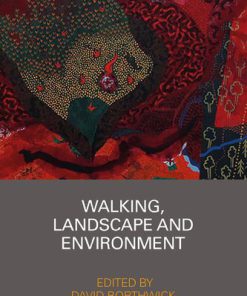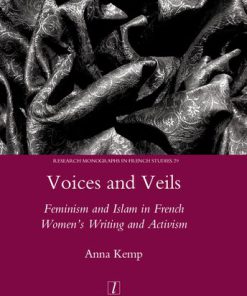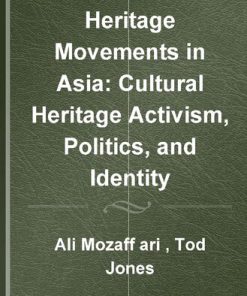Female Agency and Documentary Strategies Subjectivities Identity and Activism 1st Edition by Boel Ulfsdotter, Anna Backman Rogers Editor ISBN 147441947X 978-1474419475
$50.00 Original price was: $50.00.$25.00Current price is: $25.00.
Female Agency and Documentary Strategies Subjectivities Identity and Activism 1st Edition by Boel Ulfsdotter, Anna Backman Rogers Editor – Ebook PDF Instant Download/Delivery: 147441947X, 978-1474419475
Full dowload Female Agency and Documentary Strategies Subjectivities Identity and Activism 1st Edition after payment

Product details:
ISBN 10: 147441947X
ISBN 13: 978-1474419475
Author: Boel Ulfsdotter, Anna Backman Rogers
This book, like its twin volume Female Authorship and the Documentary Image, centres on pressing issues in relation to female authorship in contemporary documentary practices. Addressing the politics of representation and authorship both behind and in front of the camera, a range of international scholars now expand the theoretical and practical framework informing the current scholarship on documentary cinema, which has so far neglected questions of gender.
Female Agency and Documentary Strategies centres on how self-portraiture and contemporary documentary manifestations such as blogging and the prevalent usage of social media shape and inform female subjectivities and claims to truth. The book examines the scope of authorship and agency open to women using these technologies as a form of activism, centring on notions of relationality, selfhood and subjectivity, and includes interviews with Hong Kong based activist filmmaker and scholar Vivian Wenli Lin and Spanish documentarist Mercedes Alvarez.
Female Agency and Documentary Strategies Subjectivities Identity and Activism 1st Table of contents:
PART ONE NEW MEDIA AND ACTIVISM
1. THE PENCIL OF IDENTITY: INSTAGRAM AS INADVERTENT (FEMALE) AUTOBIOGRAPHY
Of the cultural objects generated by the rise of ubiquitous digital media, few are perhaps more loathed than the selfie. The simple act of taking your own picture and distributing it via social media to the public is apparently symptomatic of any number of social and individual ills. It has been deemed the icon of social narcissism, an emblem of our collective tendency to get lost in ourselves. It has also been classified as a symptom of mental illness and a risk indicator for suicide, evidence of an overwhelming lack of a sense of self.² Generationally, they seem to be…
2. ARCHETYPE AND AUTHENTICITY: REFLECTIONS ON AMALIA ULMAN’S EXCELLENCES & PERFECTIONS
Between April and September 2014, the Argentine-born artist Amalia Ulman presented herself online as an ‘Instagram Girl’.¹ Using popular hashtags from micro-celebrities on the social network, Ulman created a three-part performance work that explored how women present themselves online. Entitled Excellences & Perfections, the project saw Ulman take on the roles of ‘cute girl’, ‘sugar baby’ and ‘life goddess’, characters that were chosen, Ulman says, because ‘they seemed to be the most popular trends online (for women)’.² By the final post of the project on 19 September 2014, Ulman had amassed 88,906 followers. At this point, Ulman revealed that the project…
3. BLOGGING THE FEMALE SELF: AUTHORSHIP, SELF-PERFORMANCE AND IDENTITY POLITICS IN FASHION BLOGS
Since the mid-2000s, the rise of fashion bloggers who create their own small fashion media universes has fostered a new space for the enactment and performance of fashionable identities. Fashion blogs are online fashion diaries or journals, usually run by a single person who writes about her or his views on current or past fashion trends and shares stories about her or his daily dressing habits, beauty regimes or their latest, fashionable purchases.¹ Today, a select crowd of the most successful fashion bloggers and other ‘digital influencers’ has reached the upper echelons of the fashion industry’s social hierarchy and sits…
PART TWO RELATIONALITY, SELFHOOD AND SUBJECTIVITIES
4. ‘SCRIPTRIX NARRANS’: DIGITAL DOCUMENTARY STORYTELLING’S RADICAL POTENTIAL
Agnès Varda, the highest ranked female director in Sight and Sound’s 2014 poll of greatest documentaries in ‘Best Documentaries of All Time’,¹ embraces a mode of activist cinema in her Les glaneurs et la glaneuse/The Gleaners and I (2000) that subverts classical theory through a unique ‘cinécriture’, according to Delphine Bénézet. Together with ‘a visual and verbal emphasis on female embodiment’, Varda’s documentaries offer what Bénézet characterises as ‘a voice of resistance [in] her commitment to resist norms of representation and diktats of production’.² Hers is the voice of the ‘subject’ as ‘agent’ proudly claiming her own filmmaking.
The Gleaners…
5. HYBRID PRACTICES AND VOICE MAKING IN CONTEMPORARY FEMALE DOCUMENTARY FILM
Voice has been written about from various perspectives in documentary, from Nichols’s conceptualisation of the ‘voice of documentary’² to situating it as a social function in enabling the previously unrepresented a measure of agency. In documentary film, voice can also refer to modes of address in narration or how interviews are used. Underpinning many of these ideas around voice have been gendered concerns about who speaks, who is spoken of and how the speaking occurs, revealing issues of representation, identity and power.
The concept of voice continues to be, as Chion muses, a ‘grist for poetic outpourings’ not least because…
6. RECORD KEEPING: FAMILY MEMORIES ON FILM – REA TAJIRI’S HISTORY AND MEMORY: FOR AKIKO AND TAKASHIGE AND WISDOM GONE WILD
Memory travels not only across time and history but within families. The legacies of one generation are passed onto the following generation, tasking them with understanding and interpreting what may have not been possible to understand at the time. This is especially true for traumatic events.
To pass on a history it needs to be told, it needs to be heard and seen, it needs to be experienced and felt in the body mind. Even unwanted histories find their way back into the body mind psyche despite the efforts to eliminate what one generation would rather forget. A parent’s silence…
7. ‘NOT BECAUSE MY HEART IS GONE; SIMPLY THE OTHER SIDE’: FRANCESCA WOODMAN’S RELATIONAL AND EPHEMERAL SUBJECTIVITY AT THE LIMIT OF THE IMAGE
Francesca Woodman’s personal history, more specifically her suicide at the age of only twenty-two years old, is often used as an heuristic framework through which her highly intricate and complex photographic work is read retroactively. Peggy Phelan,³ for instance, in an essay that despite beautiful elucidation of her work elides Woodman’s fascination with photography as the commemorative medium of the twentieth century (a century that paid witness to death and genocide on an astronomic scale) and the tragic facts of her own biography, has asserted that Woodman’s work is a kind of ritualised rehearsal for an act of disappearance;⁴ Isabella…
8. OTHER WOMEN: THINKING CLASS AND GENDER IN CONTEMPORARY BRAZILIAN DOCUMENTARY FILM
Brazilian society is among the most unequal in the world, and the cinema métier in Brazil reproduces its social and economic asymmetries. The majority of Brazilian film directors are male, white and middle or upper class. The country’s few female film directors are also white, well educated and from middle or upper class backgrounds, which seems to influence their low engagement with feminist issues. The feminist agenda may not apply to privileged Brazilian women in the same way that it applies to the majority of the nation’s women, who are systematically oppressed not only for their gender positions, but also…
INTERVIEW: ‘VISUALISING OUR VOICES’ – HONG KONG SCHOLAR AND FILM DIRECTOR VIVIAN WENLI LIN IN CONVERSATION WITH BOEL ULFSDOTTER
Who is Vivian Wenli Lin? I shall let the following statement, found on the website for Reel Women Hong Kong, serve as introduction:
Vivian Wenli Lin is a Taiwanese-American video artist, documentary filmmaker, and media educator who was born and raised in San Francisco, California. In 2007, she founded Voices of Women Media – a non-profit organization that offers multimedia workshops to marginalized communities of women – including teenage girls, asylum seekers, victims of human trafficking, and sex workers in Amsterdam’s Red Light District. Vivian also facilitates One Minute Junior workshops and Training for Trainers workshops for UNICEF and The…
PART THREE IDENTITY POLITICS OF DOCUMENTARY
9. FROM VISCERAL STYLE TO DISCOURSE OF RESISTANCE: READING ALKA SADAT’S AFGHAN DOCUMENTARIES ON VIOLENCE AGAINST WOMEN
Since the fall of the Taliban numerous Afghan women from different professional backgrounds have actively engaged in making documentaries.¹ Very few of them, however, have managed to turn their filmmaking activity into effective international careers. This is why Alka Sadat (Figures 17 and 18), a self-taught documentarian from Herat, stands out as one of the most dynamic Afghan female directors of factual films. At first glance, Sadat’s output does not differ from other documentary footage coming from Afghanistan. Just like her contemporaries, her camera focuses on social problems and human rights in the war-torn country. Yet, she enjoys a strong…
10. DOCUMENTING GEORGIA IN TRANSITION: THE FILMS OF SALOMÉ JASHI AND NINO KIRTADZE
Since the break-up of the Soviet Union, Georgia has been caught between its communist past and capitalist future, between its ancient traditions and its desire to modernise, between the sphere of influence of Russia and of European/American interests, and perhaps most crucially for visual culture, between the nebulous and ill-defined notions of East and West.¹ It has frequently fallen to women to document and comment upon Georgia’s state of liminality and transition. This chapter focuses on the films of Nino Kirtadze and Salomé Jashi, as two standout examples of a tendency in Georgian cinema towards transitional documentary, a form that…
11. PROFESSION: DOCUMENTARIST: UNDERGROUND DOCUMENTARY MAKING IN IRAN
Profession: Documentarist (Herfeh: Mostanadsaz, 2014) is an illustrative example of the feminisation of Iranian civil society in recent decades. Azadeh Kian documents how women filmmakers, as well as writers and publishers, emerged in significant numbers among the urban, educated, middle classes from the 1990s onward.¹ In the last twenty years fertility rates have dropped in Iran, from an average of seven births per woman to two, a figure comparable with most industrialised countries. By 2008, the number of female university students outnumbered male students by 60 per cent.² The filmmakers of Profession: Documentarist are representative of this new social group…
12. ‘REFLECTING THROUGH IMAGES’: THE DOCUMENTARIES OF MERCEDES ÁLVAREZ
On an August afternoon in 2015, I had the opportunity to talk at length with experimental documentarist Mercedes Álvarez on the spacious terraza of Ca la Maria in the heart of Barcelona. This was actually our second meeting; the first had taken place in La Floresta, north of Barcelona, in 2004.¹ Mercedes – the director of two acclaimed documentaries, El cielo gira (The Sky Spins, 2004) and Mercado de futuros (Futures Markets, 2011) – is a soft-spoken person, with a warmth and intensity as she enters into a discussion about the cinema. In her two full-length documentaries, Mercedes has played…
People also search for Female Agency and Documentary Strategies Subjectivities Identity and Activism 1st:
female director documentary
female documentary filmmakers
female documentary
female agency definition
best female documentary directors
You may also like…
Engineering - Engineering - General & Miscellaneous
Uncategorized
Female and Male Fertility Preservation Michael Grynberg Editor Pasquale Patrizio Editor
Uncategorized
Uncategorized
Voices and Veils Feminism and Islam in French Women s Writing and Activism 1st Edition Anna Kemp
Arts - Film
The Colonial Documentary Film in South and South East Asia 1st Edition Ian Aitken (Editor)
Politics & Philosophy - Social Sciences
Politics & Philosophy - Social Sciences










